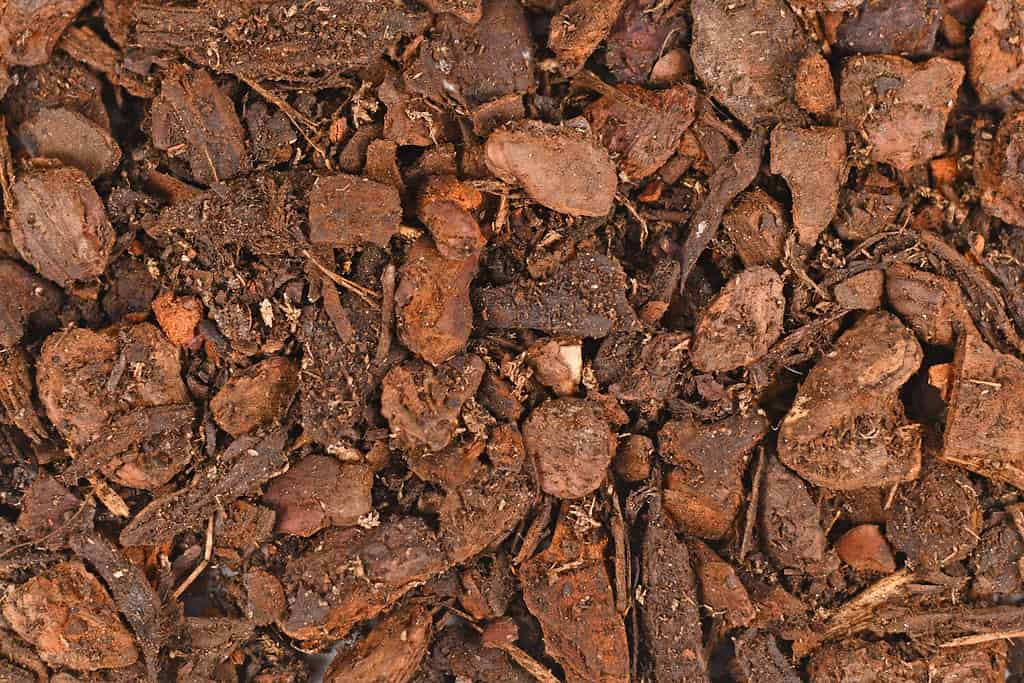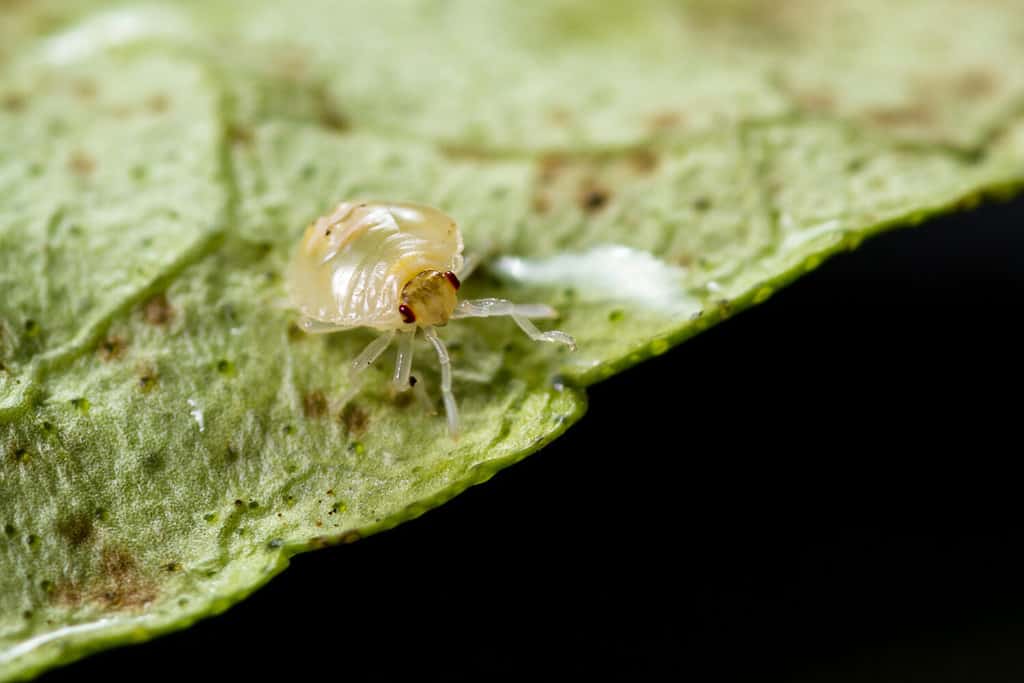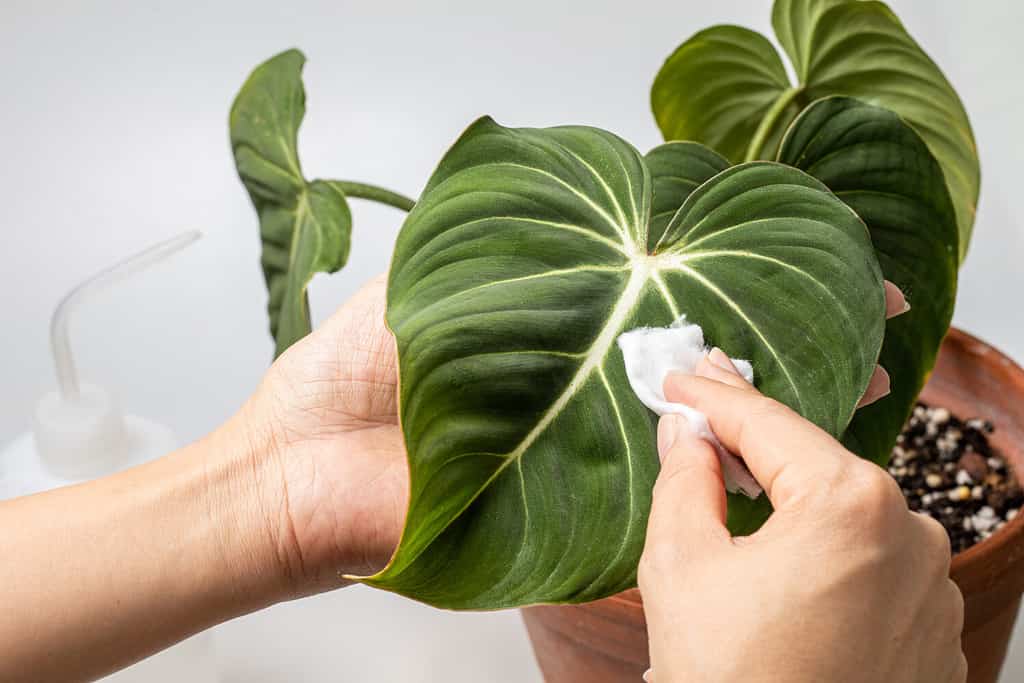Philodendrons are a versatile genus of tropical plants that have become a favorite among decorators and plant collectors over the years. With so many options to choose from in all shapes, tones, and sizes, there’s a philodendron for everyone. Add in a low-maintenance nature, and you’ve got a plant for the ages! In this article, we’ll discuss caring for your Rojo Congo philodendron with top tips to help this luscious tropical beauty thrive.
Let’s dig in!
What Are Rojo Congo Philodendron Plants?

Rojo Congo plants are a hybridized version of Imperial Red Philodendrons (pictured here) and Green Congo Philodendrons.
©Mid Tran Designer/Shutterstock.com
Like many philodendron plants, the Rojo Congo is a tropical plant with stunning waxy leaves and the ability to thrive under adverse conditions. This philodendron hybrid used to be rare and hard to find, but it is becoming more popular among nurseries and collectors.
The Rojo Congo, sometimes called Congo Rojo, is a hybrid variety created from two parent species: Philodendron Imperial Red (for which it’s often confused) and Philodendron Green Congo. It’s no surprise that the name of this plant translates to Red Congo from Spanish.
Appearance
Congo Rojo offers the best features of its parent plants. Its broad, waxy leaves are a deep, rich green tone with red undertones. As this philodendron grows and the leaves mature, the red tones will become more prevalent. The red underbelly is noticeable with new growth as well, showing itself as a new leaf unfurls.
This philodendron will grow up to four feet tall with proper care — far shorter than the monstrous Imperial Red!
Native Region
Philodendrons are native to South America, where they grow in rainforests under dense canopies, thriving on humid air and dappled sunlight. However, Rojo Congo philodendrons were hybridized in Florida. They require the same tropical environment to survive, but it’s an important distinction.
Uses
The deep green leaves and red hues make this beautiful philodendron ideal for interior design. It looks fantastic in a floor planter or elevated on a low stool. Place it with other tropical plants or in your bathroom for a relaxing jungle effect.
Toxicity
Unfortunately, the Congo Rojo and other philodendrons are toxic. This plant genus isn’t suitable for homes with pets or small children who may get their hands or mouths on the plant.
Plant Parent Experience Level
Rojo Congo philodendron plants are easy to care for. They have basic watering and fertilization requirements and can withstand a bit of neglect. This option is ideal for beginners who want a bold, eye-catching plant without dedicating too much time and effort.
Now, let’s dig into the top care tips for your Rojo Congo plant.
1. Soil Needs

Adding organic matter, like mulch, will improve airflow and nutrient content that helps your philodendron thrive.
©Firn/Shutterstock.com
Rojo Congo plants need a balanced soil that offers sufficient drainage while offering a bit of moisture retention. Regular potting soil is sufficient, but you should add perlite or coir for extra airflow and drainage to help your plant flourish. Adding organic matter also helps this stunning plant thrive.
Philodendrons are aroids like Pothos and Monsteras. Look for an aroid soil blend or anything marketed toward related plants.
2. Selecting the Right Pot
Rojo Congo philodendrons are pretty carefree when it comes to potting. Choose something with plenty of drainage and enough space to grow without providing too much room to roam, and watch it thrive. Ceramic and clay pots with drainage holes are perfect for this plant.
3. Sunlight Requirements

Like spider plants, philodendron Rojo Congo likes bright, indirect sunlight.
©iStock.com/Greenseas
As previously mentioned, the Rojo Congo grows under large, tropical trees in the rainforest. They receive dappled sunlight diffused by the dense canopy above.
Replicate this environment by providing bright, indirect sunlight. This philodendron will tolerate some shade. Bright, direct sunlight will scorch your leaves and leech essential moisture from your plant.
4. Watering Requirements
Water this plant regularly when the top inch of soil is dry — typically once weekly during the active growing season. Watering frequency will slow down in the cooler months. Testing the soil with your finger is the best way to stay vigilant.
Watering can be a higher maintenance task, but you can set reminders or use a watering app to stay on top of it. Place a mister by your plant so you remember to give it an extra dose of moisture every day.
5. Fertilizing Frequency
Your philodendron doesn’t require fertilization to survive, but it helps support growth and longevity. Treat with an aroid-friendly fertilizer or mix in organic matter monthly throughout the active growing season.
6. Common Philodendron Pests

Watch for signs of spider mites on your philodendron.
©Wollertz/Shutterstock.com
Pests love the long stalks and broad leaves on Congo Rojo philodendrons. Check your plant regularly for signs of spider mites, mealy bugs, scale insects, and thrips.
If you find signs of these common indoor plant pests, remove them manually with a damp cloth and mild detergent. If the infestation is overwhelming or they keep returning, treat it with an insecticide, fungicide, or neem oil.
7. Pruning Requirements
This low-maintenance plant doesn’t require pruning to thrive. However, you should remove dead or dying leaves from your Congo Rojo to redirect nutrients and keep it looking fresh. Remember to do some digging if you notice leaves withering or changing color.
Brown, dry leaves indicate insufficient moisture. Correct this with an updated watering schedule and a tray of pebbles and water under your plant.
Yellow leaves indicate a nutrient deficiency, over-fertilization, or general disdain toward its environment. Check that your philodendron is getting enough water and light, adjusting the placement and frequency as needed.
8. How to Propagate Philodendrons
Stem cuttings are the best method for propagating philodendrons, and Congo Rojo is no exception.
- Water your philodendron a day or two before propagating to ensure it’s ready to heal. Plan to propagate at the beginning of the growing season (spring to early summer).
- Set up a workspace with clean cutting tools, soil, and a clean glass of water.
- Cut an established stem from your Congo Rojo, choosing one with at least two nodes (preferably more).
- Put the cut stem in the glass of water. The leaf should be above the water line. Place in indirect sunlight.
- Change the water every 2-3 days, watching for signs of fogginess.
- After 1-2 weeks, look for signs of root growth. When the Rojo Congo roots, transfer the cutting to well-draining potting soil.
- Water your new Congo Rojo thoroughly and place it in bright, indirect sunlight. Follow regular care tips from here on out.
If your Congo Rojo cutting hasn’t sprouted roots in 4-6 weeks, try again with a new stem.
9. Repotting Philodendrons
Rojo Congo philodendrons are slow growers and don’t require frequent repotting. Change pots, allowing for two inches between the root ball and sides of the new pot, when you notice roots creeping out the bottom.
If you don’t fertilize your Rojo Congo regularly, consider repotting every two years to replenish soil nutrients.
10. How to Stake and Support Growth
Unlike most philodendrons, the Rojo Congo isn’t a climber! However, its large leaves can use some extra support as it grows.
Consider adding a trellis, bamboo stake, or moss pole to your Rojo Congo’s pot for extra stability. While it may not climb, a well-cared-for Rojo Congo will grow aerial roots and grip the support system. Use twine to gently tie it to the pole until it finds its footing.
11. Where to Place Your Philodendron
Place your philodendron a bit back from a sunny window. Avoid placing it too close to prevent leaf scorching.
Ensure your humidity and heat-loving plant is placed away from vents and drafts. You can move this lovely plant outdoors during the summer in humid, coastal locales.
12. How to Care for Philodendron Leaves

Philodendrons should be wiped down periodically to remove dust.
©AngieYeoh/Shutterstock.com
Dust or wipe down your Congo Rojo leaves at least once a month. This habit will help prevent pest infestations and ensure your plant can properly photosynthesize and grow.
13. Overwintering Philodendrons
These tropical plants can stay outdoors year-round in USDA zones 9-11. However, you should overwinter them indoors if you’re outside these regions — a good frost will kill your Rojo Congo.
Philodendrons enter a dormant state during the winter. Reduce watering frequency and avoid fertilization or propagation during this period.
14. Preparing Philodendrons for Spring
After the winter dormancy, you can set your Rojo Congo up for success with good cleaning, pruning, and fertilization. Start increasing the watering frequency and watch this beauty grow!
The photo featured at the top of this post is © Marianna Palacios/Shutterstock.com
Thank you for reading! Have some feedback for us? Contact the AZ Animals editorial team.






